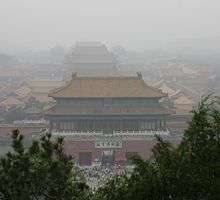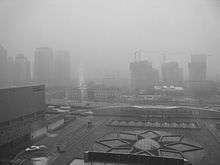Road space rationing in Beijing
Road space rationing in Beijing was introduced in the city in a permanent basis after successful results obtained with the policy during the 2008 Summer Olympics. Road space rationing or driving restriction is a transportation demand management regulation aimed to reduce traffic by restricting automobile travel through means such as restriction of cars that could enter common road space based upon the last digits of the license number on certain established days during certain periods in Beijing. The main objective of this restraint policy in Beijing is to reduce the amount of exhaust gas generated by motor vehicles.
Also as part of the smog alert system put in place in the city in 2013, once a red alert is issued, a temporary driving restriction is imposed for the duration of the severe pollution event to reduce the city’s cars on the streets by half. Temporary restrictions have been implemented in Beijing twice in December 2015, and one more time in December 2016.
Many road space rationing regulations, such as the even-odd license plate policy, yellow label car policy, end-number policy and passenger car purchase policy have been established in Beijing since the 2008 Summer Olympics. These policies are enforced by traffic enforcement cameras that are able to recognize license plates of automobiles and the police, where the cameras and policemen could recognize license plates of cars that should not be on the road during a certain day, and when found out, the driver of the car would receive certain penalties. Although there have been a significant improvement in the air quality of Beijing and the road space availability, many negative responses of the city's car owners were received.
2008 Beijing Olympics road space rationing
A 40% daily reduction of vehicle emissions was reported after comparing the data for vehicle emissions before and after the following policy was carried out.[1]
Odd-even license plate policy

On July 20, 2008, Beijing implemented a temporary road space rationing policy, odd-even rationing policy, by allowing cars that have an even last number of their license plates to be able to drive on roads in one day while the cars that have an odd last number of their license plates could go on the road the next day in order to improve air quality in the city during the 2008 Summer Olympics.[2][3] This policy does not affect taxis, public buses, yellow-plate vehicles (vehicles with more than 9 seats inclusive), police vehicles and military vehicles.
Post-Beijing Olympics road space rationing
Due to the success in improving Beijing's air quality and the increased road space availability, the Beijing Traffic Management Bureau issued a series of road space rationing policies to maintain road space availability after the 2008 Beijing Olympics.
End-number license plate policy

On September 28, 2008, the Beijing Traffic Management Bureau issued a 'Notice on the Implementation of Traffic Management Measures', which stated that from October 11, 2008 to January 10, 2009, automobiles in Beijing city (inside the 5th Ring Road) shall cease going on public roads for one day per week by means of grouping by the end number of the license plates of automobiles: from Monday to Friday, automobiles with end numbers 1 or 6, 2 or 7, 3 or 8, 4 or 9, 5 or 0 respectively would cease going on public road space.[4] License plates ending with English letters are categorized as 0. The automobiles that are not allowed on public road space during a weekday are not allowed to be inside the 5th ring road (inclusive) from 07:00 to 20:00 Beijing time. If the policy is violated, car owners would be fined ¥200. For every three months, the automobiles that could not go on public road space for a certain weekday would rotate.[5]
Yellow-label car policy
Yellow-label cars are automobiles that have yellow-stickers that indicate the vehicles are not qualified for the emission levels ‘国I’ for gasoline cars and '国III' for diesel cars on their windshields. Since January 1, 2009, a yellow-label car restriction policy was imposed, which prohibited the entrance of yellow-cars into the 5th Ring Road of Beijing.[6]
Pollution red alert

Temporary driving restrictions were imposed in Beijing from December 8 to 10, 2015, as part of the smog mitigation measures provided for in Beijing’s red alert for hazardous smog, the first such alert issued ever. The smog alert system was put in place in 2013, and a red alert should go into effect if there is a prediction that the air quality index will stay over 200 for more than 72 hours. On the evening of December 7 the index was 253 according to Beijing’s authorities. Under a red alert half of the city’s cars are ordered off the streets through a temporary alternate-day travel scheme based on the cars license plate numbers. Only cars with even-numbered license plates were allowed on the roads during the first day of the restriction.[7][8] Electric cars are not subject to the driving restriction, as a government incentive to promote the use of cleaner vehicles.[9]
According to the Ministry of Environmental Protection, the combined effect of all the restrictions imposed reduced pollutant emissions in Beijing by 30% during day one of the city's first red alert for smog. Environmentalist from Beijing University of Technology estimated that without the measures, the density of PM2.5 would have risen by 10% during that time period.[10]
A second red alert for pollution was issued on December 18, 2015. Temporary driving restrictions were imposed for four days, beginning at 7 a.m. on December 19th and ending on the 23rd at midnight.[11]
On 16 December 2016, Beijing authorities declared a five-day pollution “red alert” due to a heavy pollution event. Among other measures, about half the cars were restricted through a temporary alternate-day travel scheme, and older and “dirty” high-emissions vehicles were forbidden to circulate. Public transport services in the city were increased, with about 3,600 buses on duty. The Ministry of Environmental Protection reported that 21 other cities across north and central China had also declared pollution red alerts, including Tianjin, Shijiazhuang, Taiyuan, and Zhengzhou.[12][13] The red alert was lifted on 22 December 2016 as the winds cleared pollution away the night before.[14]
Small passenger car purchase policy
Starting from January 1, 2012, Beijing citizens who wish to purchase passenger cars with less than five seats must follow the small passenger car purchase policy to be applicable for purchasing a passenger car. According to the policy, the individual purchaser must not already have a passenger car registered under his or her name, and must fulfill various requirements such as having a driving license and living in Beijing; if the purchaser fulfills all of the requirements, he or she could apply for a quota for a passenger by entering the information pertaining to being applicable at the 'Beijing Small Passenger Car Passenger Quota Management' website, and then wait for the monthly license plate 'lottery' (摇号), where during the 26th of every month the Traffic Management Bureau would take all of the eligible quotas and select a certain amount of them randomly similar to the way of lottery where numbers are drawn randomly.[15] Companies are also applicable to following the policy, but under a different set of rules. Car owners who scrapped their cars could produce evidence and receive a quota without going through the process of license plate 'lottery'.
Effects of the policies

According to a third party test, the policies issued were great in reducing the car emissions: a 40% daily reduction of vehicle emissions was reported after comparing the data for vehicle emissions before and after the following policy was carried out. Also, according to a professor in the Beijing University of Technology, the End-number License Plate Policy has reduced the number of cars on the public road-space of Beijing by 700,000, but with the rapidly increasing number of cars purchased, the effects of the policy would be negated within three years.[16]
Reception of policies
According to a survey ordered by the officials conducted by a third party institute in 2010, 90.4% of the surveyed people are in favor of end-number license plate policy and would like to continue practicing the policy, but according to a similar survey conducted by Sina.com 82.9% of the interviewed opposed the End-number License Plate Policy, with only 14% in favor, having a 76% difference from the official survey.[17]
Other Chinese cities
As of June 2016, in addition to Beijing, another 11 Chinese cities have similar restriction schemes in place.[18]
See also
References
- "Pequim vai adotar rodízio de veículos durante os Jogos" (in Portuguese). Agencia Xinhua. 2008-03-28. Retrieved 2008-04-08.
- "Car restrictions begin in Beijing". BBC News. 2008-07-20. Retrieved 2008-07-25.
- Andrew Jacobs (2008-04-14). "Traffic Beijing Stops Construction for Olympics". New York Times. Retrieved 2008-04-14.
- "北京交管推十项新政 尾号限行停驶日每月轮换" (in Chinese). 2008-10-10. Retrieved 2012-04-07.
- "工作日高峰时段区域限行继续 4月9日起限行机动车车牌尾号轮换" (in Chinese). Beijing Traffic Management Bureau. 2012-04-05. Archived from the original on 2012-05-09. Retrieved 2012-05-05.
- 张淼淼 (2008-12-30). "Beijing:Yellow-label Car Restriction Policy Imposed" (in Chinese). Xinhua News. Retrieved 2012-05-05.
- Te-Ping Chen (2015-12-07). "Beijing Issues First-Ever Red Alert for Hazardous Smog". Wall Street Journal. Retrieved 2015-12-08.
- Edward Wong (2015-12-07). "Beijing Issues Red Alert Over Air Pollution for the First Time". The New York Times. Retrieved 2015-12-08.
- Benjamin Dooley (2015-12-08). "Beijing slashes traffic in pollution red alert". Agence France-Presse. Yahoo! News. Retrieved 2015-12-08.
- "Red alert cuts Beijing emissions by 30%". Xinhua News Agency. China Daily. 2015-12-12. Retrieved 2015-12-19.
- Edward Wong (2015-12-17). "Beijing Issues a Second 'Red Alert' on Pollution". The New York Times. Retrieved 2015-12-19.
- Phillips, Tom (2016-12-17). "Beijing smog: pollution red alert declared in China capital and 21 other cities". The Guardian. Retrieved 2016-12-25.
- "China Focus: A city sighs as Beijing's heavy smog continues". Xinhua. Xinhua English News. 2016-12-20. Retrieved 2016-12-25.
- Blanchard, Ben (2016-12-22). "Blue skies return to Beijing as wind clears dangerous pollution". Reuters. Retrieved 2016-12-25.
- "《北京市小客车数量调控暂行规定》实施细则(修订)" (in Chinese). Beijing Small Passenger Car Passenger Quota Management. 2011-12-27. Retrieved 2012-05-09.
- 尹蔚 (2009-05-27). "北京尾号限行效果逐渐消失 3年后逼近原水平" (in Chinese). Beijing News. Retrieved 2012-05-11.
- 王姝 (2010-04-06). "北京尾号限行:官方显示九成支持网调仅14%赞成" (in Chinese). XinJing News. Retrieved 2012-05-11.
- "The great crawl". The Economist. 2016-06-18. Retrieved 2016-06-22. From the print edition.
External links
- Beijing Traffic Management Bureau
- Beijing Small Passenger Car Quota Management Website
- Will a Driving Restriction Policy Reduce Car Trips? - A Case Study of Beijing, China, Environment for Development, September 2013.
- Review of Beijing’s Comprehensive Motor Vehicle Emission Control Programs, White Paper, International Council on Clean Transportation (ICCT), October 2015.